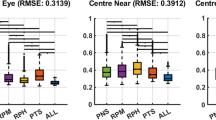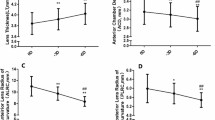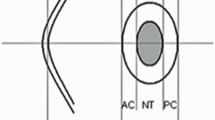Abstract
Our measurements of in vitro changes in the focal properties of the human crystalline lens as a function of accommodative state and age demonstrate that presbyopia is a lens based phenomenon and that there may be a lens mediated drift towards a more hyperopic refractive state with ageing. The blur of the image formed by the lens changes as a function of age and accommodative state. Ocular image quality varies with accommodative state and pupil size. Although changes in ocular image quality with accommodative state are analogous to lens changes, there are qualitative differences between lens and ocular image quality. Asymmetric ocular image quality, mediated in part by tilt and decentration of the optical elements, combines with symmetrical blur to influence all methods of retinal imaging. Confocal scanning laser ophthalmoscopy (CSLO) is degraded least by retinal blur followed by scanning laser ophthalmoscopy (SLO) and lastly by conventional fundus imaging. Optimisation of ocular image quality through the choice of pupil centration, has produced the first real-time videoimages of the human cones. These results also have clinical implications to the development of refractive error and to the design of refractive corrections.
Access this chapter
Tax calculation will be finalised at checkout
Purchases are for personal use only
Preview
Unable to display preview. Download preview PDF.
Similar content being viewed by others
References
Cook CA, Koretz JF, Pfahnl A, Hyun J, Kaufman PL. Aging of the human crystalline lens and anterior segment.Vision Res 1994;34:2945–2954.
Brown N. The change in lens curvature with age. Exp Eye Res 1974;19:175–183.
Smith G, Atchison DA, Pierscionek BK. Modeling the power of the aging human eye. J Opt Soc Am 1992;9:2111–2117.
Glasser A, Campbell MCW. Changes in focal length and spherical aberration of the human lens with ageing. In: Vision Science and its Applications: Technical Digest. Washington,D.C.: Optical Society of america, 1996;1:246–249.
Kroeger RHH, Campbell MCW, Munger R, Fernald R. Refractive index distribution and spherical aberration in the crystalline lens of the African cichlid fish, Haplochromis burtoni. Vision Res 1994;34:1815–1823.
Duane A. Normal values of the accommodation at all ages. J Am A 1912;59:1010–1013.
Glasser A, Campbell MCW. Physical and optical changes in the human crystalline lens with age and their relationship to presbyopia. Invest Ophthalmol Vis Sci 1996;37:S757.
Slataper FJ. Age norms of refraction and vision. Arch Ophthalmol (NY) 1950;43:468–481.
Howcroft MJ, Parker JA. Aspheric curvatures for the human lens. Vision Res 1977;17:1217–1223.
Brown N. The change in lens curvature with age. Exp Eye Res 1974;19:175–183.
Jenkins TCA. Aberrations of the eye and their effects on vision. Brit J Physiol Optics 1963;20: 59–91, 161-201.
Westheimer G, Liang J. Influence of ocular light scatter on the eye’s optical performance. J Opt Soc Am A 1995;12:1417–1424.
Lu C, Munger R, Campbell MCW. Monochromatic aberrations in accommodated eyes. In: Vision Science and its Applications: Technical Digest. Washington, D.C.: Optical Society of america, 1993;3:160–163.
Atchison DA, Collins MS, Wildsoet CF, Christensen J, Waterworth MD. Measurement of monochromatic ocular aberrations of human eyes as a function of accommodation by the Howland aberroscope technique. Vision Res 1995;35:313–323.
Campbell MCW, Harrison EM, Simonet P. Psychophysical measurement of the blur on the retina due to optical aberrations of the eye. Vision Res 1990;30:1587–1602.
Howland HC, Howland B. A subjective method for the measurement of the monochromatic aberrations of the eye. JOpt Soc Am 1977;67:1508–1518.
Walsh G, Charman WN, Howland, HC. Objective technique for the determination of monochromatic aberrations of the human eye. JOpt Soc Am A 1984;1:987–992.
Campbell FW, Gubisch RW. Optical quality of the human eye. J Physiol (Lond) 1966;186:558–578.
Santamaria J, Artal P, Bescos J. Determination of the point spread function of human eyes using a hybrid optical-digital method. JOpt Soc Am A 1987;4:1109–1114.
Roorda A, Campbell MCW. The relationship between double and single pass image quality of the eye. Invest Ophthalmol Vis Sci 1994;35:S1258.
Artal P, Marcos S, Navarro R, Williams DR. Odd aberrations and double pass measurements of retinal image quality. J Opt Soc Am A 1995;12:195–201.
Liang J, Williams DR. Effect of higher order aberrations on image quality in the human eye. In: Vision Science and its Applications: Technical Digest. Washington, D.C.: Optical Society of america, 1995;1:70–73.
Roorda A. Double pass reflections in the human eye [dissertation]. Waterloo: University of Waterloo, 1996.
Schwiegerling J, Greivenkamp JE, Miller JM. Representation of videokeratoscopic height data with Zernike polynomials. J Opt Soc Am A 1995;12:2105–2113.
Howland HC, Buettner J, Applegate RA. Computation of the shapes of normal corneas and their monochromatic aberrations from videokeratometric measurements. In: Vision Science and its Applications: Technical Digest. Washington, D.C.: Optical Society of america, 1994;2:54–57.
Wilson MA, Campbell MCW, Simonet P. Changes of pupil centration with change of pupil size. Optom and Vis Sci 1992;69:129–136.
Walsh G, Charman WN. The effect of pupil centration and diameter on ocular performance. Vision Res 1988;28:659–755.
Tscherning A Physiologic Optics, (trans. Weiland G.). 4th ed. Philadelphia: Keystone Publishing Co.,1924.
Bing L, Campbell MCW. The change of monochromatic aberrations with lens tilt and pupil decentration in a four aspheric surface model eye. Invest Ophthalmol Vis Sci 1994;35:S1803.
Snyder AW, Miller WH. Photoreceptor diameter and spacing for highest resolving power. J Opt Soc Am 1977;67:696–698.
Liang J, Williams DR, Miller, D. Imaging photoreceptors in the living eye with adaptive optics. This volume
Roorda A, Campbell MCW. Comparison of the influence of ocular aberrations on three fundus imaging techniques. OSA Annual Meeting: Technical Digest. Washington D.C.: Optical Society of america, 1996; accepted
Atkinson MR, Roorda A, Campbell MCW. Imaging of individual photoreceptors: Optical possibilities beyond the incoherent resolution limit. Invest Ophthalmol Vis Sci 1995;36:188.
Elliott D, Whitaker D, MacVeigh D. Neural contribution to spatiotemporal contrast sensitivity decline in healthy ageing eyes. Vision Res 1990;30:541–547.
Cuiffreda K. Accommodation and its anomalies. In: Cronly-Dillon JR, editor. Vision and visual dysfunction. Vol 1: Visual Optics and Instrumentation. Charman WN, editor. London: The Macmillan Press, 1991:231–279.
Bartmann M, Schaeffel F. A simple mechanism for emmetropization without cues from accommodation or colour. Vision Res 1994;34:873–876.
Wildsoet CF, Howland HC, Falconer S, Dick K. Chromatic aberration and accommodation: Their role in emmetropization in the chick. Vision Res 1993;33:1593–1603.
Collins MJ, Wildsoet CF, Atchison DA. Monochromatic aberrations and myopia. Vision Res 1995;35:1157–1163.
Gwiazda J, Thorn F, Bauer J, Held R. Emmetropization and the progression of manifest refraction in children followed from infancy to puberty. Clin Vis Sci 1993;8:337–344.
Sivak JG, Ryall LA, Weerheim J, Campbell MCW. Optical constancy of the chick lens during pre-and post-hatching ocular development. Invest Ophthalmol Vis Sci 1989;30:967–974.
Kroeger RHH, Fernald RD, Campbell MCW. The refractive index distribution and optical quality of the crystalline lens of the African cichlid fish, Haplochromis burtoni, as a function of lens size and lighting condition during development. Vision Res submitted.
Bennett AG and Rabbetts RB. Clinical visual optics, 2nd ed. Toronto: Butterworths, 1989.
Author information
Authors and Affiliations
Editor information
Editors and Affiliations
Rights and permissions
Copyright information
© 1997 Springer Science+Business Media Dordrecht
About this chapter
Cite this chapter
Campbell, M.C.W., Glasser, A., Roorda, A. (1997). Clinical Implications of Changes in Lens and Ocular Imaging Properties. In: Lakshminarayanan, V. (eds) Basic and Clinical Applications of Vision Science. Documenta Ophthalmologica Proceedings Series, vol 60. Springer, Dordrecht. https://doi.org/10.1007/978-94-011-5698-1_10
Download citation
DOI: https://doi.org/10.1007/978-94-011-5698-1_10
Publisher Name: Springer, Dordrecht
Print ISBN: 978-94-010-6403-3
Online ISBN: 978-94-011-5698-1
eBook Packages: Springer Book Archive




